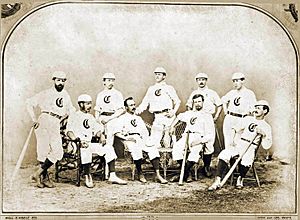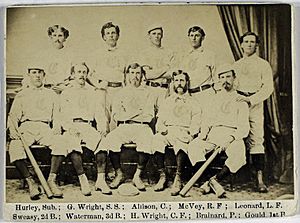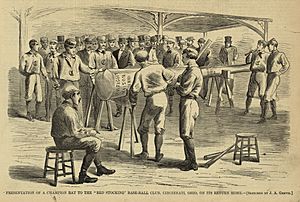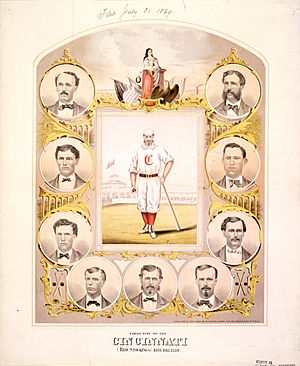Cincinnati Red Stockings facts for kids
The Cincinnati Red Stockings of 1869 were a very special baseball team. They were the first team where all the players were paid, making them the first "all-professional" baseball team! This team started in 1866 as the Cincinnati Base Ball Club. They played in the National Association of Base Ball Players (NABBP) from 1867 to 1870.
This was a time when baseball was changing a lot. People in Cincinnati and a player named Harry Wright helped shape these changes. In fact, Major League Baseball officially celebrated 100 years of professional baseball in 1969 because of this team!
The Red Stockings were very successful. They traveled all over the country, which was a big deal back then. They also set trends for team uniforms and nicknames that are still used today. They made the color red famous for Cincinnati baseball, which is why the city's current team, the Reds, still uses red. They even inspired the "Red Sox" name for the team in Boston!
Contents
Starting the Baseball Club
The Cincinnati Base Ball Club began on July 23, 1866. They created rules and chose leaders. One of the first presidents was Alfred T. Goshorn.
The club had a strong connection with the Union Cricket Club. This helped the baseball team become very successful.
After playing a few games in 1866, Cincinnati joined the NABBP in 1867. They agreed to play at the Union Cricket Club grounds. Many cricket club members joined the baseball team, making it stronger. This also made more people interested in baseball.
They planned a new clubhouse and a better fence around the field. Members of both clubs could watch games for free. Other people paid a small fee to watch.
The team soon got the nickname "Red Stockings." This was because of their special uniforms, which had long red stockings. Long stockings were new and exciting for team uniforms back then!
Harry Wright came to Cincinnati in 1866 to work for the Union Cricket Club. The next year, he also took on baseball duties. He is often called the team's "manager" from this time. He found and trained players for the 1868 season. His team won 16 games against local teams, only losing to the touring Nationals from Washington. This loss taught the Cincinnati team a lot about how to play better.
About half of the 1868 Red Stockings players came from eastern cities. They were likely paid in some way. Two top hitters, John Hatfield and Fred Waterman, came from the New York Mutuals. This was one of the strongest teams around. Asa Brainard was a pitcher for the Brooklyn Excelsiors. Catcher Doug Allison came from a strong Philadelphia club. Charlie Gould was a local player from a rival team. Harry Wright was still the main pitcher, sharing the role with Brainard. The 1868 team played many games and traveled east. They were great against western teams but lost seven of 43 games overall.
The First Professional Team
In 1869, the NABBP allowed professional teams. Harry Wright and George Ellard then created a fully professional team. They paid ten players a salary for eight months, from March 15 to November 15. Wright played center field and helped organize the team's defense. His younger brother, George Wright, joined the team in 1869. He was the best player on the team, and maybe even the best of his time!
The professional Cincinnati Red Stockings played their first game on May 4, 1869. They won 45–9 against the Great Westerns of Cincinnati. The team won 57 games and lost zero against other Association clubs. They played over 60 games in total. They traveled across the country, visiting Boston and San Francisco. This was a huge and unique tour for a baseball team. Their first season ended on November 6. The Cincinnatis beat the Mutuals of New York 17–8 at home.
In 1870, the team continued to win many games. They won about 24 games before losing 8–7 to the Brooklyn Atlantics in Brooklyn on June 14. This game went for eleven innings! The Red Stockings were still one of the strongest teams, losing only six games all year. However, fewer people came to watch their games, especially at home.
A Perfect Season
In 1869, the Red Stockings had a perfect record of 57 wins and 0 losses. This is the only perfect season in professional baseball history! They were also the first team to play games on both the East and West coasts in the same year. More than 2,000 people greeted the team when they arrived in San Francisco.
A Reds historian named Greg Rhodes said, "They really helped nationalize the game and put Cincinnati on the map as a baseball town."
The End of the Team
On June 14, 1870, the Cincinnati Red Stockings lost 8–7 to the Brooklyn Atlantics. This ended their amazing streak of 81 wins in a row! The game was played in front of 20,000 fans.
In November 1870, the club's leaders decided that paying professional players was too expensive. They decided not to have a team for 1871. The club then officially broke up.
Harry Wright was hired to start a new professional club in Boston. He signed three of his Cincinnati teammates to join him. This new team, the Boston Red Stockings, played in the first professional league in 1871. Many former Cincinnati Red Stockings players moved to other teams. But the Wright brothers stayed with the Boston team for five years.
The current Cincinnati Reds team sees itself as connected to the original Cincinnati Red Stockings. The Boston Red Stockings, which started with half of the Cincinnati team, later became the Boston Braves. This team is now in Atlanta and still uses red in its uniforms. The Boston Red Sox, started in 1901, got their name from this old nickname in 1908.
Famous Players
The 1869 team had ten players. The main nine players returned for 1870 in the same positions:
- Asa Brainard, Pitcher
- Doug Allison, Catcher
- Charlie Gould, First Base
- Charlie Sweasy, Second Base
- Fred Waterman, Third Base
- George Wright, Shortstop
- Andy Leonard, Left Field
- Harry Wright, Center Field/Manager
- Cal McVey, Right Field
- Dick Hurley, substitute
From 1867, Harry Wright did many jobs for the team. He was like a modern manager, general manager, and travel planner all in one! In 1868, he and Brainard shared pitching and second base. Allison, Gould, and Waterman played the other bases. Sweasy and Leonard played for a rival team in Cincinnati. Only Gould was from Cincinnati; the others were from the East.
In 1871, the main nine players split up. Gould, the Wright brothers, and McVey went to the Boston Red Stockings. Brainard, Allison, Sweasy, Waterman, and Leonard joined the Washington Olympics.
Team Records
Before Cincinnati hired its professional team in 1869, the strongest baseball clubs were in the eastern United States. In 1867 and 1868, Cincinnati only lost to these eastern teams. They won 16 and 29 games without losing to any western opponents.
| Year | Games | Won | Lost | Tied | Rank in wins |
|---|---|---|---|---|---|
| 1867 | 18 | 17 | 1 | 0 | 10th in wins |
| 1868 | 43 | 36 | 7 | 0 | 4th |
| 1869 | 65 | 65 | 0 | 0 | 1st |
| 1870 | 74 | 67 | 6 | 1 | 2nd |
Here are their records for championship matches against professional teams in 1869–1870:
| Year | Games | Won | Lost | Tied | Rank in wins |
|---|---|---|---|---|---|
| 1869 | 19 | 19 | 0 | 0 | 1st in wins |
| 1870 | 34 | 27 | 6 | 1 | 2nd |





